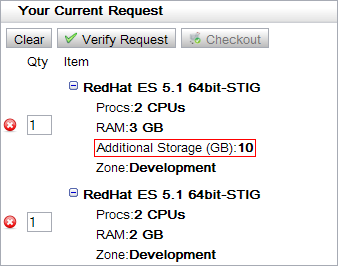During the Create VPC process, users accessing the portal are able to "build" their desired VPC using a wizard-like interface. The "building" process defines how many reservations (VMs) they want in their VPC, and what resources are assigned to each reservation. Basically, the "queue" informs the user what their desired VPC would contain. Users queue up how many reservations they want and what resources to use, and then they can check the ability of this VPC against Moab. The following image is an example of how the queue might look if the user wants two reservations in their desired VPC:

5.1.3.1.1 Queue Data
Within the <queue-item> element is one or more child <requirement-data> elements. This is a required element. This element defines the data that is stored from each component each time the user adds a new item to the request queue. The requirement data stored should map to a requirement defined in the <request> element.
Typically, all components dealing with an individual reservation should be stored as part of the queue item's requirement data. These are components like the processor count, amount of memory, and so forth. Components that are global to the entire VPC (like the start time and duration), do not need to be stored in the <requirement-data> element.
5.1.3.1.2 Example
A user wants a VPC with three reservations. The reservations have 1 GB, 2 GB, and 3 GB RAM respectively. To store this information, each queue item must store the user-selected amount of memory. Let's assume the memory is in the memoryNumberSpinner component. Therefore, each time the user clicks the Add To Request button, the value from this component must be stored in the queue data. Here's how an administrator would do that:
<requirement-data>
<component id="memoryNumberSpinner" />
</requirement-data>
Since the start time and duration is the same across the entire VPC, there is no need to store this information in the queue.

|
Viewpoint supports multiple <requirement-data> items, and each needs to have a unique ID attribute. This allows each item in the queue to correspond to various requirements. |


